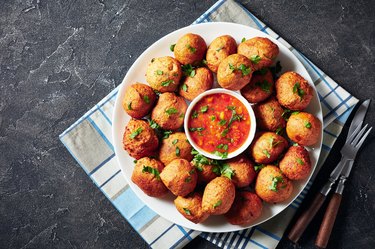
Plantains are popping up on grocery store shelves where only bananas used to be, thanks to a 41 percent increase in imports to the U.S. between 2013 and 2018, according to Consumer Reports. Unlike bananas, you can't eat raw plantains. They have a bitter flavor that is mellowed by cooking.
Eating Raw Plantains
Video of the Day
Plantains can be deceiving. They look just like large bananas. But peel one and try to eat it like a banana and you'll get quite a surprise. First of all, they are higher in starch and much lower in sugar than bananas, according to USDA data. This makes their texture more like a raw potato than a banana.
Video of the Day
Not many people think raw potatoes are tasty, although there are a few raw potato lovers out there. It's unlikely that those people would also find raw plantains delicious, however. Raw, the flesh is much more bitter than mild potatoes. Along with the texture, it's a quite unappealing victual.
However, unlike some other starchy fruits grown in tropical areas, there's no danger in eating raw plantain. According to the Food and Agriculture Organization, it doesn't contain toxic substances like cassava, which can cause cyanide poisoning if consumed raw.
Cooking With Plantains
Because of their mild flavor when cooked, plantains lend themselves well to many different preparations and recipes. They are most often used in savory dishes, but they feature in some sweets as well. Probably the most popular way of cooking plantains is deep frying. But this isn't a good choice for your waistline or heart health.
Boiling, roasting and grilling are healthier options for cooking plantains. You can boil the plantain with its skin on or off until tender, then mash it as you would potatoes. To roast or grill plantains, peel them and either slice them or leave them whole. Place them in a hot oven or on a hot grill and cook them until they are tender and easily pierced with a fork.
You can also add plantains to a one-pot meal with a Mexican flair. Cook some whole-grain brown rice and add it to a pot with sauteed onion and garlic, canned black beans, fresh tomatoes or tomato sauce, sliced plantains and a little liquid, such as water or low-sodium stock. Simmer for 10 to 15 minutes, then serve topped with fresh salsa, cilantro and green onions.
Plantains in a Healthy Diet
Plantains have a lot in common with bananas, nutritionally. The main difference is their carbohydrate makeup. Plantains are higher in carbohydrates than bananas, and most of it is starch with small amounts of fiber and sugar. Bananas contain significantly more sugar and less starch, but the same amount of fiber. There isn't much of a difference between the two in terms of vitamin and mineral content.
It's not a good idea to go overboard with bananas, and the same is true for plantains. Due to the high carb count and relatively low fiber content, plantains — like other starchy plant foods — have more of an effect on blood sugar.
While it's a good idea for everyone to watch their intake of foods that can increase blood sugar, it's especially important for people with metabolic disorders and diabetes. The Centers for Disease Control and Prevention recommends eating fewer high-starch vegetables, including plantains, potatoes, yams, squash, corn and peas, and more non-starchy vegetables, such as leafy greens, bell peppers, carrots and broccoli, which are rich in fiber and have a blood sugar-regulating effect.